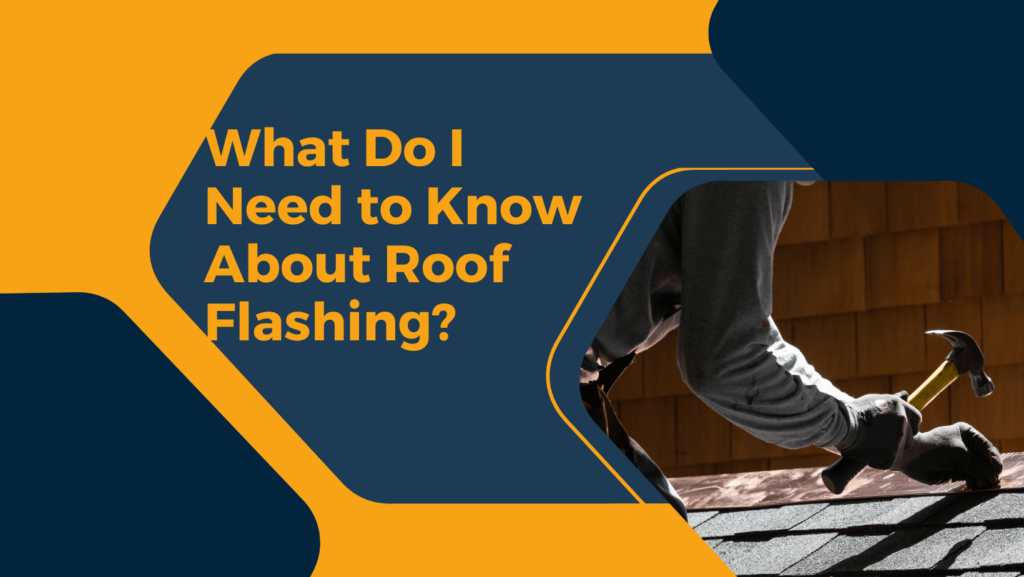What do I need to know about roof flashing from Post Oak Roofing. Your roof’s flashing is an unsung hero that rarely gets the credit for its ability to protect your roofing system and home. As one of the most crucial parts of your roofing system, it protects your home from roof leaks and all the moisture-related and structural issues that follow.

So, in today’s article, our experts have revealed everything you need to know about your roof’s flashing i.e. why it is such an important part of your roof and the various types of flashings you need for watertight protection.
What Do I Need to Know about Roof Flashing?
The flashing is installed to protect the most damage-prone areas of your roof such as cracks, openings, and joints from moisture damage. It is usually made of a thin piece of metal or some other material. The flashing is placed beneath the roofing material to direct water away from highly vulnerable underlying parts of a roof.
If you want to avoid roof leaks and subsequent flooding in your home, it is strongly recommended to invest in high-quality flashing for your roof. In absence of any flashing, water can enter beneath your roofing material and seep through your underlayment, causing roof leaks. Within a short time, it can lead to flooding in your home that can result in serious accidents like electrocutions and slip and fall accidents apart from causing severe damage to the foundation of your home.
Importance of Roof Flashing
Roof flashing is considered an extremely important part of a roofing system due to several reasons. Firstly, it protects the most vulnerable areas of your roof. Therefore, it must be installed at the points where the roofing surface meets the protrusions like chimneys, skylights, and walls. Secondly, professionals make sure to place it in the valleys or low points of your roof i.e. the meeting points of two slopes. Flashings are very effective in stopping water from entering a valley, getting in between the walls, or infiltrating your vents or skylights.
Roof Flashing: Materials and Types
Metal flashings are the most popular type of flashing available anywhere. Some of the popular options in metal flashings are:
- Copper
- Aluminum
- Steel
Copper flashing: Copper is known for its excellent malleability and durability. It has a very long lifespan. On the downside, it is susceptible to discoloration in absence of proper care. Copper flashing is a good choice if you want to protect your chimneys.
Steel flashing: Steel is one of the most common choices for roof flashing. Apart from aesthetics, steel is malleable and galvanized steel corrosion resistant as well.
Aluminum flashing: Aluminum is lightweight and can be easily formed into any shape. These qualities make it a very popular choice among property owners and roofers alike. However, make sure to choose an aluminum flashing with a protective coating. In absence of any coating, aluminum can deteriorate over time.
Types of Flashings:
1. Kickout Flashing: the main purpose of a kick-out flashing is to direct water away from the walls and down into the gutters.
2. Skylight Flashing: This type of flashing provides a weatherproofing layer for your skylight. The skylight flashing has several sections that prevent water intrusion through your skylight and roof.
3. Step Flashing: This is essentially a wall flashing. It bends at an angle of 90 degrees in the middle. When installing step flashing, several different layers of flashing pieces are installed to ensure water flows uniformly into the gutters.
4. Valley Flashing: This flashing offers a reliable way to direct water down the roof and directly into the gutters. Valley flashing can effectively protect the critical areas of your roof such as roof valleys from water infiltration.
5. Drip Edge: This flashing is installed to direct water away from the fascia and to prevent it from getting underneath the roofing material. It is installed at the roof’s edges.
6. Continuous Flashing: This type of flashing is made of a long piece of metal that is used to direct water down the roof.
7. Base Flashing: This flashing is installed where the roof’s surface meets the wall or any other vertical surface. It protects this damage-prone area from water damage.
8. Counter Flashing: Counter flashing is installed to protect and cover the base flashing by preventing water intrusion.
Get In Touch
Now that you know the basics of your roof flashing, we hope that you’ll make an informed choice when choosing flashings for your roof. Contact Post Oak Roofing today at 469-363-6273 if you need any roofing services. We service areas in Allen, Tyler, Plano, McKinney, and DFW, TX.
